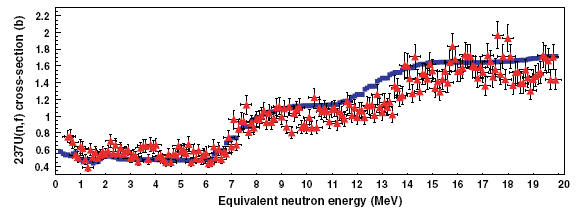Basic Research for an Era of Nuclear Energy at LBNL, LLNL, AND LANL
Basic Research for an Era of Nuclear Energy
 The Advanced Energy Initiative announced by the President in his 2006 State-of-the-Union Address aims towards the development of “a new Global Nuclear Energy Partnership to address spent nuclear fuel, eliminate proliferation risk, and expand the promise of clean, reliable, and affordable nuclear energy”.
The Advanced Energy Initiative announced by the President in his 2006 State-of-the-Union Address aims towards the development of “a new Global Nuclear Energy Partnership to address spent nuclear fuel, eliminate proliferation risk, and expand the promise of clean, reliable, and affordable nuclear energy”. Figure below, chart of main transformations in advanced U-TRU fuels.
Measurements using the neutrons from a reactor on a sample of a pure isotope require an understanding of the "neutron spectrum" (the number of neutrons of a given energy) making the analysis complicated and such measurements may not cover the full range of energies of interest for proposed transmutation methods. Measurements with beams of neutrons at specific energies are hard since tunable beams of neutrons are difficult to produce. A program of these measurements is underway at, for instance, the LANSCE facility at Los Alamos. Direct measurements of several of the most important neutron-induced cross-sections (including those on major actinide nuclei) have been made over the years and have achieved very high accuracy. However, many more relevant cross sections are needed and may be inaccessible to direct methods.
 Recently a complementary technique using "surrogate reactions" was proposed by scientists at Lawrence Livermore National Laboratory. A dedicated experimental program, involving a collaboration of scientists from LLNL, Lawrence Berkeley National Laboratory, and the University of Richmond, is now running at the 88-Inch Cyclotron facility of LBNL. Accuracies to better than 10% can now be achieved using this technique.
Recently a complementary technique using "surrogate reactions" was proposed by scientists at Lawrence Livermore National Laboratory. A dedicated experimental program, involving a collaboration of scientists from LLNL, Lawrence Berkeley National Laboratory, and the University of Richmond, is now running at the 88-Inch Cyclotron facility of LBNL. Accuracies to better than 10% can now be achieved using this technique.
Figure above, an example, which shows the 237U fission cross section deduced relative to the well known case of 235U. The only direct neutron-induced fission cross-section information on 237U came from a measurement which used the neutrons from a weapons test in the early 1970’s – an experiment unlikely to be repeated! The new measurement achieves an unprecedented accuracy of better than 10% over a very wide energy range.
Having established the utility of the method, an experimental program of measuring cross sections of interest is now underway at Lawrence Berkeley National Laboratory. While a great deal of effort is being focused on meeting the Nation’s need for measurements relevant to advanced fuel cycles, the surrogate technique will also be used in other areas of pure and applied nuclear physics which involve hard-to-determine cross sections. One example is to use the technique to determine cross sections of astrophysical interest, particularly those involved in neutron-induced nucleosynthesis, which will be required in order to understand the abundance of elements in the Universe.




